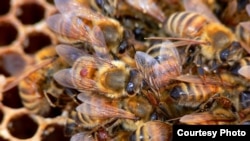Honeybees are in trouble. Each year since 2006, one-third of their hives have been wiped out by a mysterious disease called Colony Collapse Disorder.
While experts aren't certain, they believe poor hive management, overworked bees, pesticides or parasitic mites could be to blame.
A beekeeper in Frederick, Maryland, is working on breeding a queen bee that can help her hive withstand the assault.
Breeding a better bee
Adam Finkelstein manages to keep his small operation healthy. He keeps some 200 hives not far from Washington, D.C..
His bees spend the winter in hives which are naturally insulated with honey to keep them warm in the coolest months. This time of year, the bees have begun their daily sorties to collect nectar.
Finkelstein has five bee yards at the core of his breeding program. “We’re testing for yield, gentleness, the ability to get through the winter, the ability to build up in the spring, the ability to make honey and the ability to be thrifty and to keep alive during periods when there is no food.”
His major focus is on breeding a stronger queen resistant to the varroa mite, a parasite originally from Asia that carries viruses into the hive and has become a major problem for beekeepers in the U.S. and elsewhere.
“Our bees handle this mite just fine and produce honey and can pollinate and can make more bees and that’s our goal and we’re getting there,” he says.
Artificial insemination
Finkelstein says breeding is a work in progress. He uses artificial insemination, which allows him to select desirable traits from both male and female.
The procedure isn’t difficult, he says, but takes practice and patience. Working from his home laboratory, he first sedates the queen using carbon dioxide.
“While she is anesthetized, we use a very small set of instruments to position a syringe and deliver a known quantity of semen," he says. "And that’s it. She’s mated.”
Pesticide-free operation
Finkelstein tests his queens in his many hives. Once he's evaluated their traits, he sells them, making room for new queens.
He maintains a pesticide-free operation, unlike most commercial producers who depend on chemical treatments to keep their bees healthy.
“However, eventually, if the treatments fail to work or if the level of toxicity in the wax in the beehives becomes so great and the queens are not fertile," he says, "then those folks will probably turn towards a hardier, more mite tolerant queen choice.”
Finkelstein happily says a few of those bigger operations have begun to collaborate with him, recognizing that the future of beekeeping may not be about the next best pesticide, but about queens bred to produce offspring that can resist pathogens.
While experts aren't certain, they believe poor hive management, overworked bees, pesticides or parasitic mites could be to blame.
A beekeeper in Frederick, Maryland, is working on breeding a queen bee that can help her hive withstand the assault.
Breeding a better bee
Adam Finkelstein manages to keep his small operation healthy. He keeps some 200 hives not far from Washington, D.C..
His bees spend the winter in hives which are naturally insulated with honey to keep them warm in the coolest months. This time of year, the bees have begun their daily sorties to collect nectar.
Finkelstein has five bee yards at the core of his breeding program. “We’re testing for yield, gentleness, the ability to get through the winter, the ability to build up in the spring, the ability to make honey and the ability to be thrifty and to keep alive during periods when there is no food.”
His major focus is on breeding a stronger queen resistant to the varroa mite, a parasite originally from Asia that carries viruses into the hive and has become a major problem for beekeepers in the U.S. and elsewhere.
“Our bees handle this mite just fine and produce honey and can pollinate and can make more bees and that’s our goal and we’re getting there,” he says.
Artificial insemination
Finkelstein says breeding is a work in progress. He uses artificial insemination, which allows him to select desirable traits from both male and female.
The procedure isn’t difficult, he says, but takes practice and patience. Working from his home laboratory, he first sedates the queen using carbon dioxide.
“While she is anesthetized, we use a very small set of instruments to position a syringe and deliver a known quantity of semen," he says. "And that’s it. She’s mated.”
Pesticide-free operation
Finkelstein tests his queens in his many hives. Once he's evaluated their traits, he sells them, making room for new queens.
He maintains a pesticide-free operation, unlike most commercial producers who depend on chemical treatments to keep their bees healthy.
“However, eventually, if the treatments fail to work or if the level of toxicity in the wax in the beehives becomes so great and the queens are not fertile," he says, "then those folks will probably turn towards a hardier, more mite tolerant queen choice.”
Finkelstein happily says a few of those bigger operations have begun to collaborate with him, recognizing that the future of beekeeping may not be about the next best pesticide, but about queens bred to produce offspring that can resist pathogens.











